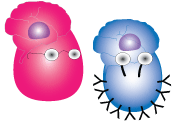
T cell differentiation
Let me tell you a story that you by now have heard many times before! After a pathogen enters the body, alarm bells ring in the form of cytokines being secreted by many different inflammatory cells as well as antigen presenting cells like macrophages and DCs. These antigen-loaded sentinels move to the secondary lymphoid tissues where naïve T cells check out their peptide:MHC complexs and become activated, as we saw in the previous page. An activated T cell now release IL-2 which causes it to proliferate and a process called differentiation is started whereby the T cell develops into one of several subpopulations such as Th1, Th2, Tr1, and Th17, to mention a few. You can tell the different subpopulations apart by the kind of cytokines they secrete. For example, Th1 cells are characterised by their secretion of IFN-γ, and Th2 cells by IL-4, IL-5 and IL-13. Killer T cells also differentiate into subpopulations secreting different cytokines. This is often overlooked, perhaps because their main job is not to secrete cytokines but to kill!
The differentiation pathway taken by uncommitted naive T cells depends on what cytokines neighbouring cells are secreting at the time of activation and these neighbouring cells are often APC. Let's take a closer look at how the Th1 and Th2 subpopulations develop and are maintained. When DC secrete IL-12 during antigen presentation, naive Th cells go down the Th1 pathway. Why is this? First of all, it is because IL-12 acts on the T cell and turns on many genes including the IFN-γ gene leading to IFN-γ production, but it is also because IL-12 at the same time represses other genes associated with Th2 differentiation and therefore stops cytokines like IL-4 from being produced. Likewise, with IL-4 present in the environment (possibly released by basophils) during T cell activation, genes associated with the Th2 pathway are stimulated leading to more IL-4 being produced, which in turn, also represses genes of the Th1 pathway. In other words, the cytokines produced by one subset turns the opposing subset off. However, there is a constant shift in the balance between these stimulating and repressing signals which means that in some activated Th cells there will be no definite Th1 or Th2 cytokine profile but a mix of IFN-γ, IL-4 and IL-5, and these Th cells belong to the Th0 subset.
But Th0, 1 and 2 are far from the only Th subsets that arise from the naive CD4+ T cell. Let's explore a few more in the next page...